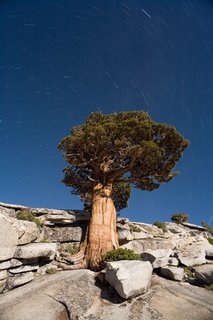Noise Reduction in Post-Processing
While the 5D, and many other DSLR's, can remove long exposure noise by using an in-camera dark frame, it's also possible to perform a similar process in post-processing (i.e., in PhotoShop). This is especially useful if your DSLR does not have the ability to do in-camera noise reduction.
Back in 2004, Jeff Medkeff published an article titled "Using Image Calibration to Reduce Noise in Digital Images". Along with his great explanation of the different types of noise in digital images, he gives a very clear outline of how to photograph a dark frame in the field, and how to use the dark frame to remove digital noise using PhotoShop. Since my DSLR doesn't support in-camera noise reduction, I've been using this technique for the past year, and it has worked great.
If anyone would like to do some experiments to compare in-camera noise reduction against this post-processing approach, I'd love to hear what you learn.








